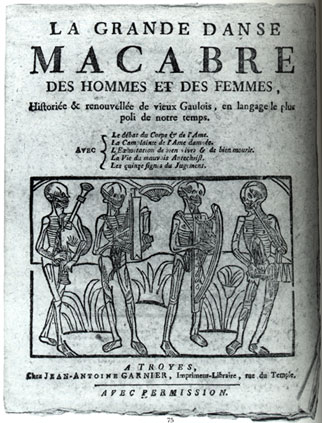
The Dance of Death
The theme of the ‘Dance of death’, relatively common in medieval European literature and art, did not manifest itself in Spain until the beginning of the fifteenth century. The anonymous Danza de la muerte (or Danza general), probably an imitation of an earlier French model, is composed of seventy-nine coplas de arte mayor (twelve-syllable octaves) in dramatic form. The figure of Death summons representatives of many classes of society –emperor, cardinal, duke, archbishop, abbot and a host of lesser clerics and laymen –to appear in turn before him. Each protests or makes a plea for forgiveness. But Death, pointing out their faults and vices, unswervingly condemns all to join in the funeral dance.
From The Dance of Death
Here begns the general dance, in which it is shown how Death gives advice to all, that they should take due account of the brevity of life, and not to value it more highly then it deserves;; and this he orders and requires, thaty they see and hear attentively what wise preachers tell them and warn them from day to day, giving them good and wholesome counsel that they labour in doing good works to obtain pardon of their sins; and showing them by experience what he says, calls and requires from all classes, whether they come willingly or unwillingly; and thus beginning:
Lo! I am Death! With aim as sure as steady,
All beings that are and shall be I draw near me.
I call thee,-I require thee, man, be ready!
Why build upon this fragile life?–Now hear me!
Where is the power that does not own me, fear me?
Who can escape me, when I bend my bow?
I pull the string,-thou liest in dust below,
Smitten by the barb my ministering angels bear me.
Come to the dance of Death! Come hither, even
The last, the lowliest,-of all rank and station!
Who will not come shall be by scourges driven:
I hold no parley with disinclination.
List to yon friar who preaches of salvation,
And hie ye to your penitential post!
For who delays,-who lingers,-he is lost,
And handed o’er to hopeless reprobation.
I to my dance–my mortal dance-have brought
Two nymphs, all bright in beauty and in bloom.
They listened, fear-struck, to my songs, methought;
And, truly, songs like mine are tinged with gloom.
But neither roseate hues nor flowers’ perfume
Will now avail them, -nor the thousands charms
Of worldly vanity;-they fill my arms,-
They are my brides,-their bridal bed the tomb.
And since ‘tis certain, then, that we must die,-
No hope, no chance, no prospect of redress,-
Be it our constant aim unswervingly
To tread God’s narrow path of holiness:
For he is first, last midst. O, let us press
Onwards! And when Death’s monitory glance
Shall summon us to join his mortal dance,
Even then shall hope and joy our footsteps bless.
Anonymous
